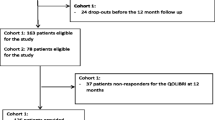Summary
The Glasgow Outcome Scale (GOS)-Score is the most widely used instrument for measuring outcome in head injury research. Its reliability is seen controversial because of its simplicity. The study analyzes the correlation between the levels 3 to 5 of recovery to medical data, psychology and quality of life (QOL) 4 to 8 years after the accident. 34 patients, suffered from a severe brain injury (BI) 4 to 8 years ago, were reexamined by a psychological test battery and by evaluating of QOL (using self developed items for private and social activity). Test results and GOS-Scores additionally were correlated to data from the phase of intensive care.
Patients, still alive 4 to 8 years after injury, ranged mainly between the GOS-Scores 3 to 5 of recovery. Consequently, other scores (like Ranchos los Amigos. Barthel Index, GOAT) failed in measuring the outcome after such a long time. Different parameters from the phase of intensive care correlate significantly with the patients GOS-Score: coma length, isolated brain injury versus additional extracranial injury, compression of the basal cisternes on the initial CCT. Different psychological test results and the patients quality of life correlate significantly with the GOS-Scores from 3–5. These correlations could be shown in xy and yx-direction by different mathematical models.
It is concluded, that GOS-levels 3–5 of recovery correlate to the essential medical data from the initial phase after the accident and to a detailed psychological evaluation years after injury.
Access this chapter
Tax calculation will be finalised at checkout
Purchases are for personal use only
Preview
Unable to display preview. Download preview PDF.
Similar content being viewed by others
References
Athippan S, Muthukumar N, Srinivasan S (1993) Influence of basal cisterens, midline shift and pathology on outcome in head injuries. Ann Acad Med 22: 452–455
Bowers SA, Marshall SF (1980) Outcome in 200 consecutive cases of severe head injury treated in San Diego County. A prospective analysis. Neurosurgery 3: 237–242
Bruce DA, Langfitt TW (1978) Resuscitation from coma due to head injury. Crit Care Med 7: 254–269
Couldwell WT, Fukushima T, Glanotta SL, Weiss MH (1996) Psychosocial functioning and quality of life in patients with primary brain tumors. J Neurosurg 84: 29–34
Dongen KJ, Braakmann R, Gelpke GJ (1983) The prognostic value of computerized tomography in comatose head-injured patients. J Neurosurg 59: 951–957
Formisano R, Schmidhuber-Eiler B, Salturi L, Cigany E, Birbamer G, Gerstenbrand F (1991) Neuropsychological outcome after traumatic temporal lobe damage. Acta Neurochir (Wien) 109: 1–4
Frowein RA, Firsching R (1988) Personality after head injury. Acta Neurochir 44 (Wien) [Suppl]: 70–73
Godersky JC, Gentry LR, Tranel D, Dyste GN, Danks KR (1990) Magnetic resonance imaging and neurobehavioral outcome in traumatic brain injury. Acta Neurochir (Wien) 51: 311–314
Hall KM, Karzmark P, Stevens M, Englander J, O’Hare P, Wright J (1994) Family stressors in traumatic brain injury: a two-year follow-up. Arch Phys Med Rehabil 75: 876–884
Jenett B, Bond M (1975) Assessment of outcome after severe brain damage-a pratical scale, Lancet i: 480–484
Lezak DL (1983) Neuropsychological assessment, 2nd Ed. Oxford University Press, NewYork
McLean A, Dikmen SS, Temkin NR (1993) Psychosocial recovery after head injury. Arch Phys med Rehabil 74: 1041–1046
Reider-Groswasser I, Cohen M, Groswasser Z (1993) Late CT findings in brain trauma: relationship to cognitive and behavioral sequelae and to vocational outcome. Am J Roentg 160: 147–152
Author information
Authors and Affiliations
Editor information
Editors and Affiliations
Rights and permissions
Copyright information
© 1998 Springer-Verlag Wien
About this paper
Cite this paper
Woischneck, D., Firsching, R. (1998). Efficiency of the Glasgow Outcome Scale (GOS)-Score for the Long-Term Follow-Up after Severe Brain Injuries. In: Marmarou, A., et al. Intracranial Pressure and Neuromonitoring in Brain Injury. Acta Neurochirurgica Supplements, vol 71. Springer, Vienna. https://doi.org/10.1007/978-3-7091-6475-4_41
Download citation
DOI: https://doi.org/10.1007/978-3-7091-6475-4_41
Publisher Name: Springer, Vienna
Print ISBN: 978-3-7091-7331-2
Online ISBN: 978-3-7091-6475-4
eBook Packages: Springer Book Archive




